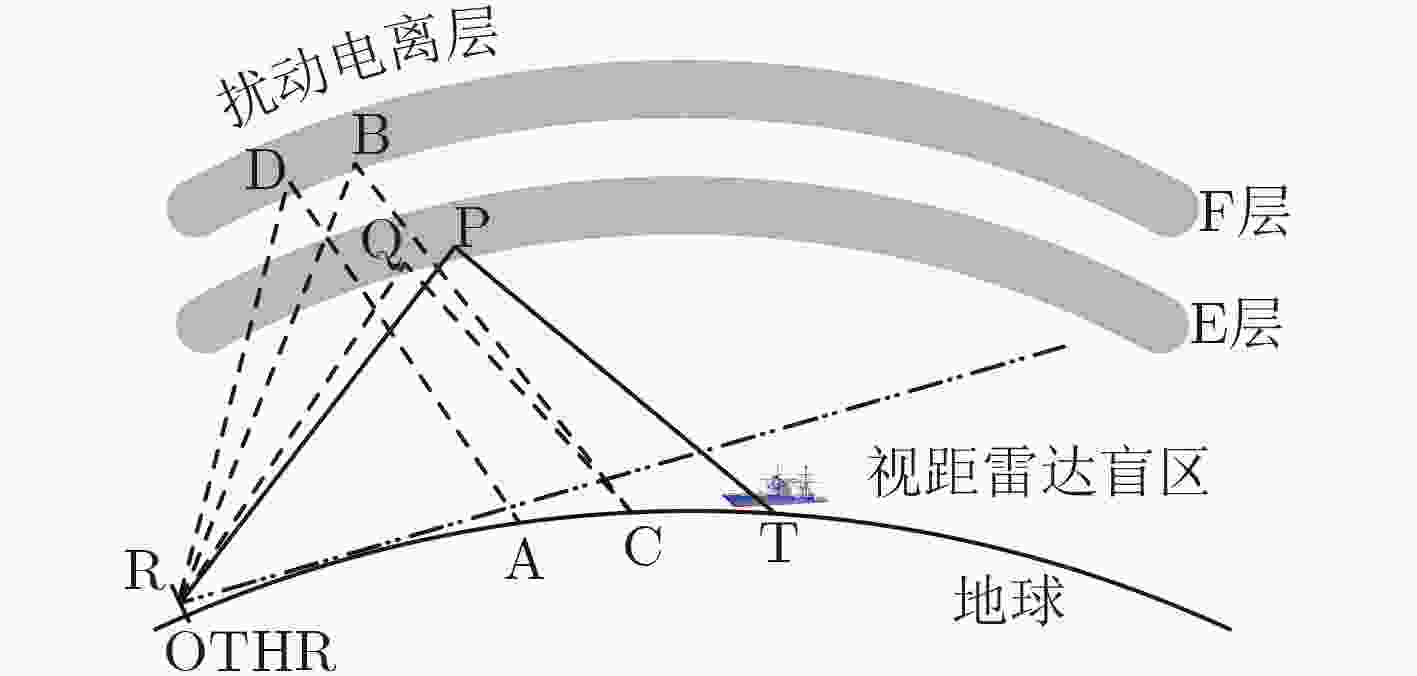Multi-mode Spread Doppler Clutter Suppression Algorithm of MIMO-OTHR Based on Bi-iterative MVDR Beamformer
-
摘要: 针对多模传播引起的扩展多普勒杂波影响天波超视距雷达对低可探测慢速舰船目标检测性能的问题,该文在新一代多输入多输出天波超视距雷达系统下,利用双迭代最小方差无失真响应(MVDR)波束形成器抑制多模扩展多普勒杂波。考虑到时间叉排线性调频连续波MIMO天波雷达和慢时间相位编码MIMO天波雷达在有限相干积累时间内的训练样本数有限,且训练样本中包含主选模式期望信号,该文利用阻塞矩阵进行数据预处理,减小训练样本中的主选模式期望信号影响,并将LN×1维“发射-接收”2维权矢量优化分解为L×1维发射权矢量和N×1维接收权矢量,通过双迭代计算恢复出的2维MVDR权矢量来抑制多模扩展多普勒杂波,减小了计算量和样本需求。理论分析和仿真验证了算法的有效性。
-
关键词:
- 天波超视距雷达 /
- 扩展多普勒杂波 /
- 多输入多输出 /
- 双迭代最小方差无失真响应 /
- 多模传播
Abstract: Spread Doppler Clutter (SDC) caused by multi-mode propagation restrains the detection performance of Over-The-Horizon Radar (OTHR) for low detectable targets, such as slow ships. To solve this problem, a bi-iterative Minimum Variance Distortionless Response (MVDR) beamformer is proposed to suppress multi-mode SDC for MIMO OTHR system. As it is difficult to obtain the signal-free training data and enough sample support in MIMO-OTHR with time-staggered linear frequency modulated continuous wave or slow time phase-coded waveforms, the block matrix is used for data preprocessing to reduce the effect of expected signal component in the training data, then multi-mode SDC could be suppressed by the LN-variate MVDR beamformer which is restored through bi-iterative calculation with an L-variate transmit and an N-variate receive beamformer. This algorithm improves the convergence of MVDR beamformer, while reducing the computational load and the requirement of sample support. Theoretical analysis and simulation experiment are presented to verify the effectiveness of this algorithm. -
表 1 各传播模式的DOD, DOA(°)
传播模式 模式1 模式2 模式3 模式4 DOD 60 47 40 55 DOA 60 57 40 45 表 2 各传播模式的归一化增益值(dB)
传播模式 模式1 模式2 模式3 模式4 迭代1次 –8.5 –55.1 –56.2 –52.8 迭代5次 –0.1 –81.7 –68.2 –63.1 -
GUO Yueyu, XU Rongqing, and WEI Yinsheng. Spread-Doppler clutter mitigation based on ionospheric irregularity learning for skywave radar[C]. IEEE 13th International Conference on Signal Processing, Chengdu, China, 2016: 1651–1654. doi: 10.1109/ICSP.2016.7878108. EARL G F and WARD B D. Frequency management support for remote sea-state sensing using the JINDALEE skywave radar[J]. IEEE Journal of Oceanic Engineering, 1986, 11(2): 164–173 doi: 10.1109/JOE.1986.1145165 ANDERSON S J and ABRAMOVICH Y I. A unified approach to detection, classification, and correction of ionospheric distortion in HF sky wave radar systems[J]. Radio Science, 1998, 33(4): 1055–1067 doi: 10.1029/98RS00877 郭欣. 天波超视距雷达信号处理技术研究[D]. [博士论文], 南京理工大学, 2003. 蔚娜, 李雪, 李铁成. 基于特征分解的多模杂波抑制方法[J]. 电波科学学报, 2016, 31(1): 85–90 doi: 10.13443/j.cjors.2015021301WEI Na, LI Xue, and LI Tiecheng. An eigenvalue decomposition based method for suppressing multi-mode clutter[J]. Chinese Journal of Radio Science, 2016, 31(1): 85–90 doi: 10.13443/j.cjors.2015021301 李雪, 郭晓彤, 王岳松, 等. 基于已知传播模式数目的海杂波抑制方法研究[J]. 电波科学学报, 2016, 31(4): 700–706 doi: 10.13443/j.cjors.2015110902LI Xue, GUO Xiaotong, WANG Yuesong, et al. Sea clutter suppression algorithm based on ionospheric propagation mode number[J]. Chinese Journal of Radio Science, 2016, 31(4): 700–706 doi: 10.13443/j.cjors.2015110902 RIDDOLLS R. Comparison of linear and planar arrays for auroral clutter control in an over-the-horizon radar[C]. IEEE Radar Conference, Seattle, USA, 2017: 1153–1158. doi: 10.1109/RADAR.2017.7944378. FRAZER G J, ABRAMOVICH Y I, and JOHNSON B A. Multiple-input multiple-output over-the-horizon radar: Experimental results[J]. IET Radar,Sonar and Navigation, 2009, 3(4): 290–303 doi: 10.1049/iet-rsn.2008.0142 FRAZER G J. Experimental results for MIMO methods applied in over-the-horizon radar[J]. IEEE Aerospace and Electronic Systems Magazine, 2017, 32(12): 52–69 doi: 10.1109/MAES.2017.170057 JOHNSON B A and ABRAMOVICH Y I. Elevation filtering in wide-aperture HF skywave Radar[C]. IEEE Radar Conference, Boston, USA, 2007: 367–372. doi: 10.1109/RADAR.2007.374244. BILIK I, KAZANCI O, and KROLIK J. Wavefront adaptive sensing for radar spread clutter mitigation[C]. IEEE International Workshop on Computational Advances in Multi-Sensor Adaptive Processing, St Thomas, USA, 2007: 185–188. doi: 10.1109/CAMSAP.2007.4497996. BILIK I, KAZANCI O, and KROLIK J. Radar clutter mitigation via space-time wavefront adaptive sensing[C]. IEEE International Conference on Acoustics, Speech, and Signal Processing, Las Vegas, USA, 2008: 2589–2592. doi: 10.1109/ICASSP.2008.4518178. 窦道祥, 李茂, 何子述. 基于稀疏重建的MIMO-OTH雷达多模杂波抑制算法[J]. 航空学报, 2015, 36(7): 2310–2318 doi: 10.7527/S1000-6893.2015.0011DOU Daoxiang, LI Mao, and HE Zishu. Multi-mode clutter suppression algorithm of MIMO-OTH radar based on sparse reconstruction[J]. Acta Aeronautica et Astronautica Sinica, 2015, 36(7): 2310–2318 doi: 10.7527/S1000-6893.2015.0011 DOU Daoxiang, LI Mao, and HE Zishu. Multi-mode clutter suppression of multiple-input-multiple-output over-the-horizon radar based on blind source separation[J]. IET Radar,Sonar&Navigation, 2015, 9(8): 956–966 doi: 10.1049/iet-rsn.2014.0302 RIDDOLLS R J, RAVAN M, and ADVE R S. Canadian HF over-the-horizon radar experiments using MIMO techniques to control auroral clutter[C]. IEEE Radar Conference, Washington, DC, USA, 2010: 718–723. doi: 10.1109/RADAR.2010.5494530. 吕晖. 集中式MIMO雷达信号处理方法研究[D]. [博士论文], 西安电子科技大学, 2011. REED I S, MALLETT J D, and BRENNAN L E. Rapid convergence rate in adaptive arrays[J]. IEEE Transactions on Aerospace&Electronic Systems, 1974, AES-10(6): 853–863 doi: 10.1109/TAES.1974.307893 严韬, 陈建文, 鲍拯. 一种基于压缩感知的天波超视距雷达短时海杂波抑制方法[J]. 电子与信息学报, 2017, 39(4): 945–952 doi: 10.11999/JEIT160576YAN Tao, CHEN Jianwen, and BAO Zheng. Sea clutter suppression method for over-the-horizon radar with short coherent integration time based on compressed sensing[J]. Journal of Electronics&Information Technology, 2017, 39(4): 945–952 doi: 10.11999/JEIT160576 ABRAMOVICH Y I, FRAZER G J, JOHNSON B A, et al. Iterative adaptive Kronecker receiver for MIMO over-the-horizon radar[C]. Proceedings of 6th International Symposium on Image and Signal Processing and Analysis, Salzburg, Austria, 2009: 22–27. STOICA P and SELEN Y. Cyclic minimizers, majorization techniques, and the expectation-maximization algorithm: A refresher[J]. IEEE Signal Processing Magazine, 2004, 21(1): 112–114 doi: 10.1109/MSP.2004.1267055 -






 下载:
下载:







 下载:
下载:
